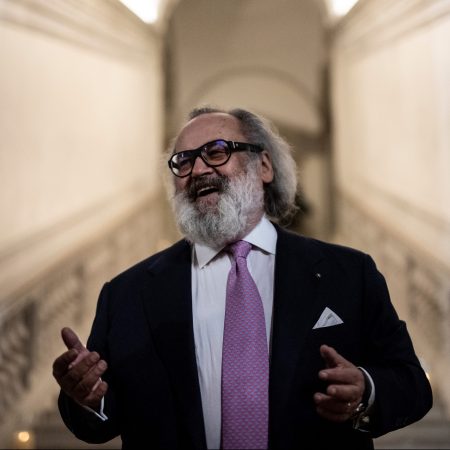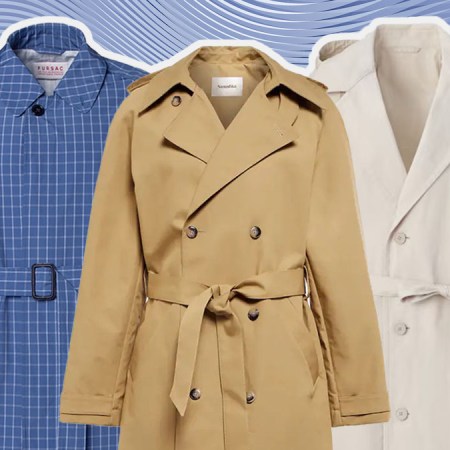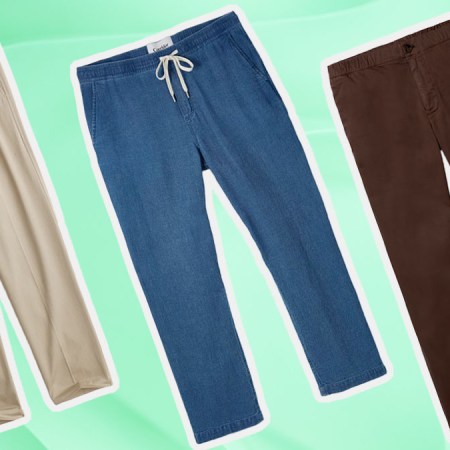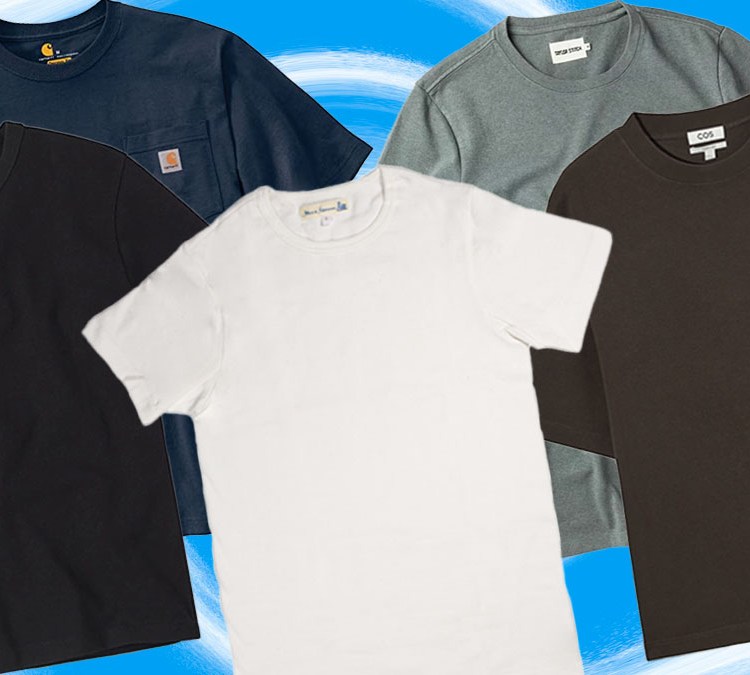Actors often prepare for a role by spending time with real-life people who partake in a similar lifestyle or career to the person they’re about to portray. To prepare for his role as a bespoke tailor in the new thriller The Outfit, actor Mark Rylance spent a week learning and working alongside the team at Huntsman. the iconic Savile Row tailoring house which has been making suits since the 1800s.
Campbell Carey is the head cutter and creative director of Huntsman, and in addition to showing Rylance the ropes, he also made the suits for the movie (though, as he shared with us, Rylance lent a helping hand when it came to his.) We had the opportunity to chat with Carey about the time he shared with Rylance, the craft of tailoring, and the legacy of Huntsman, which has dressed some of society’s most esteemed members for well over a hundred years.
Talk to me a little bit about the collaboration between yourself and the team on the film?
Mark [Rylance] joined us here on Savile Row in the middle of lockdown for a week, learning all the nuances of what it means to be a spoke tailor. So he shadowed me for a week. He sat downstairs with our tailors in the workshop and actually watched his suit being put together from start to finish. So day one, we measured him up, went through the whole measuring process, and then we cut the pattern, the three piece suit. And he really, he watched me closely for the first couple of days. I was a bit apprehensive, thinking I had offended him, but it wasn’t until day three that he started… He was taking notes all the time, and by day three, he started asking all the right questions, really. It was amazing. He would make me pause and explain what I was doing. He could have spent longer, but he really took in all he had to take in, in a week.
Were there any specific instructions you gave Mark about how to look realistic on screen in his role as a tailor?
Oh, we had him with the shearers on day two, I think. Some rough fabric, just saying cut that, and cut up and down the fabric just to handle. Because don’t forget, these shears are super heavy, they’re four or five pounds. They are super long blades. So you have to really look like you know what you’re doing. And he took to it like a duck to water. He really did. In actual fact, he cut his own suit in the end, I’d let him loose. We had some spare fabric just in case… but not at all. The tricky bits I helped with, but he did a great job. And also not just the cutting, but how to measure someone up, how to hold a tape measure, how to put a tape measure around someone, how to hold a needle and thimble, how to thread a needle, all the little things he was practicing as well. And his lunch hour, obviously it’s time to eat, and he was like, “No, I’m going to sit,” and do it all on his own. So he was a great pupil. Big fun.
Were there any challenging things to teach him?
Because he’d done a bit of sewing himself. He was actually quite adept at sewing, but I had to get him to change the way he held the thimble. You don’t use the front of the thimble, you use the side. You hold the needle and you pivot like how you pick the cloth. So trying to tell someone like that, what to do, is tricky. He got it in the end.
Mark’s character talks about how what a man wears for a suit says so much about him. What you think the suits that you made for this film say about the men you were dressing.
We get a lot of privileged actors coming through the doors, and Mark had such a say on it. He had such great input after his week of training, he really knew what he wanted. And there were as lots of different things at play, we had Mark’s character, who was fifties British, going through to the suit he made for himself was all about his escape route to another life. So transitional things going on there. And then we had Ritchie’s character, he had something to prove. So we had to make the shoulder line a little bit too wide, the padding that little bit too square, the turn back cuff was really deep, the patch pockets were really big, his lapels on his jacket and the suit jacket he wears were quite wide, the suit bottom… You know, it was all about showing that Ritchie’s a showy character and Mark is, really austere, old school, British gent; two totally different. So the clothes were so much to see. And the costume, Sophie O’Neill, her and I went back and forth loads on all the geeking out about lapels and sleeve heads. And it was great fun, really fun project to work on.
There are lots of references to Savile Row in the film, explain the significance of the Row to those who might not know.
I mean, the world of fashion has looked to Savile Row for centuries as the bastion of style, British style and men’s suiting. Back in the 50s, it wouldn’t just be Savile Row, there’d be Sackville Street, Albemarle, Conduit Street… there’d be tailors everywhere. Now it’s shrunk, where there are only like two or three streets of tailors. But back in the fifties, it was huge. And it was really then that we started the whole Hollywood connection. At Huntsman, our roll call is incredible, Hollywood royalty almost down through the years. And it’s an amazing place to work, day to day. You take it for granted when you walk through the hallowed hallways of Huntsman, but when you think who’s been here and has shopped, it’s a wonderful place.
Talk a little bit about the legacy of Huntsman and what brought you to where you are.
I was trained at Kilgour, French and Stanbury starting out in ’98, and was lucky enough to get an apprenticeship there because they were like gold dust. And I always thought that had an amazing roll call of clients, and it wasn’t until I came here, it was like, “Wow, this is something else.” And being Creative Director now, what really stands out for me is the people we have had through the doors that could have clothes made in their own atelier. So for example, Coco Chanel, Bill Blass, Hubert de Givenchy, Alexander McQueen, Mark Jacobs, all these people have access to their own manufacturing, their own ateliers, but they choose Huntsman to make their suits. That’s what amazes me when they come here for the dinner suit or their dress tails or their smoking jacket. It’s such a privilege to be considered the world renowned tailors of the highest quality. And it goes so far, we’ve got our atelier in New York, on 57th; Ralph, my old apprentice is now running that, he’s now head cutter there. We also have trunk shows all over the world. And to take that little bit Savile Row, it’s an amazing feeling.
What is the difference between a cutter and a tailor?
The cutter is the architect, and the tailor is the builder. So to become a cutter, you have to be a tailor first. You have to be able to, when you’re a cutter, tell someone if there’s something wrong with the garment. You have to be able to communicate, “When you take this to bits, you need to put it back together this way.” So you need to know every facet, as a cutter, of how something’s put together from the get go. So a master tailor, is someone who can make every facet, every aspect of a bespoke suit, from trousers to waist coats to jackets. So they can cut and make and fit. That’s what a true master tailor is — a one man band.
In the movie, Mark’s character says he thinks tailoring is not an art, it’s a craft. And I’m curious what you think about that.
I agree with that. I don’t try and force upon clients what I think. There’s too many tailors, too many people, it’s their way or the highway. And at the end of the day, it’s the clients. They’re not always right, but they’re always the customer, and you have to steer them and guide them in the right direction. Yes, the first suit they make, they order off you might not be the right one in your eyes, but kind of let them make the mistakes. And then I think that’s where the trust element builds up. I’ve got clients I’ve made for since 2000, maybe even before 1999. My first client is still with me. They want to have one stop, done. They don’t want change. So I think the craft of it, it’s a trust thing as well. There’s too many people calling themselves bespoke tailors nowadays that they’re not really, they don’t really have the training to call themselves as such.
It’s a craft. It’s a craft that you have to learn. It’s hard. It’s a long time to learn, and it takes a lot of hard work. But once you get to a cutter’s level, it’s an amazing job. You get to go all over the world, you get to meet people that you’d never meet before. It’s so rewarding as well when you see something, you have a hand in something from start to finish. So from a bunch of measurements to finishing it, walking at the door. There’s not many jobs around nowadays that you get that involvement from start to finish.
This article was featured in the InsideHook newsletter. Sign up now.





















